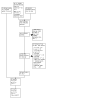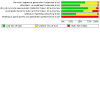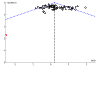Virtual reality for stroke rehabilitation
- PMID: 40537150
- PMCID: PMC12178777
- DOI: 10.1002/14651858.CD008349.pub5
Virtual reality for stroke rehabilitation
Abstract
Rationale: Virtual reality applications have emerged as a treatment approach in stroke rehabilitation, with the first randomised trial published in 2004. A wide range of applications have been tested in research studies and adopted in clinical practice, from non-immersive, non-customised, interactive game-based applications to immersive applications specifically designed for rehabilitation settings. This is an update of a Cochrane review first published in 2011 and then again in 2015 and 2017.
Objectives: Primary objective: to assess the effects of virtual reality compared with an alternative intervention or no intervention for upper limb function and activity in people after stroke.
Secondary objectives: to assess the effects of virtual reality compared with an alternative intervention or no intervention on gait and balance, global motor function, cognitive function, activity limitation, participation restriction and quality of life, and adverse events in people after stroke.
Search methods: We searched the Cochrane Stroke Group Trials Register, CENTRAL, MEDLINE, Embase, and four additional databases. We also searched trials registries up to September 2023.
Eligibility criteria: We included randomised trials in adults after stroke comparing virtual reality (an advanced form of human-computer interface that allows the user to 'interact' with a computer-generated environment in a naturalistic fashion) with alternative or usual care. We excluded studies that compared two different types of virtual reality without an alternative group and studies of participants with mixed aetiology (e.g. participants with acquired brain injury) unless data were available relating to people with stroke only.
Outcomes: The critical outcome of interest was upper limb function and activity. Important outcomes included mobility outcomes (gait speed, balance), global cognitive function, activity limitation, participation restriction and quality of life, and adverse events.
Risk of bias: We used the Cochrane RoB 1 tool to assess risk of bias.
Synthesis methods: We conducted meta-analysis using a fixed-effect model to calculate the standardised mean difference (SMD) and 95% confidence intervals (CI) for the critical outcome. We assessed the certainty of the evidence using GRADE.
Included studies: We included 190 trials involving a total of 7188 participants, of which 119 studies are newly included in the current update. The majority of studies were small, with only 36 (19%) studies involving more than 50 participants, and the largest study recruiting 152 participants. Interventions varied in terms of both the goals of treatment and the virtual reality applications used. Control groups usually received the same amount of an alternative form of therapy. In many studies risk of bias was unclear due to poor reporting. Thus, while there is a very large number of randomised controlled trials included in the review, the evidence remains mostly low or moderate certainty when rated using the GRADE system.
Synthesis of results: When comparing virtual reality with alternative therapy approaches, results suggest that virtual reality may be beneficial in slightly improving upper limb function and activity (SMD 0.20, 95% CI 0.12 to 0.28; 67 studies, 2830 participants; low-certainty evidence). When compared with alternative therapy approaches, virtual reality may have little to no effect on gait speed, but the evidence is very uncertain (10 studies, 304 participants; very low-certainty evidence). Compared to alternative therapy approaches, virtual reality may be slightly beneficial for balance (SMD 0.26, 95% CI 0.12 to 0.40; 24 studies, 871 participants; low-certainty evidence) and probably reduces activity limitation (SMD 0.21, 95% CI 0.11 to 0.32; 33 studies, 1495 participants; moderate-certainty evidence). However, there may be little to no effect on participation and quality of life (SMD 0.11, 95% CI -0.02 to 0.24; 16 studies, 963 participants; low-certainty evidence). The addition of virtual reality to usual care or rehabilitation (resulting in an increased amount of time spent in therapy for those in the intervention group) probably increases upper limb function and activity compared to usual care alone (SMD 0.42, 95% CI 0.26 to 0.58; 21 studies, 689 participants; moderate-certainty evidence). However, there may be no apparent benefit in gait speed, but the evidence is very uncertain (3 studies, 57 participants; very low-certainty evidence). Virtual reality in addition to usual care may be beneficial for balance (SMD 0.68, 95% CI 0.46 to 0.91; 12 studies, 321 participants; low-certainty evidence) and is probably beneficial for activity limitation (SMD 0.22, 95% CI 0.04 to 0.41; 15 studies, 513 participants; moderate-certainty evidence). The evidence suggests that virtual reality in addition to usual care may not have a beneficial effect on participation and quality of life (2 studies, 76 participants; low-certainty evidence). Fifty-nine studies in this review reported that they monitored for adverse events; across these studies there were few adverse events, and those reported were relatively mild.
Authors' conclusions: We found moderate- to low-certainty evidence that the use of virtual reality and interactive video gaming is slightly more beneficial than alternative therapy approaches in improving upper limb function, balance, and activity limitation. Furthermore, greater benefits were seen for upper limb function when virtual reality was used in addition to usual care (to increase overall therapy time). There was mixed evidence on the effects on mobility outcomes including gait speed, and insufficient evidence to reach any conclusions about the effect of virtual reality and interactive video gaming on participation restriction and quality of life.
Funding: This Cochrane review had no dedicated funding.
Registration: Protocol: doi.org/10.1002/14651858.CD008349 Original review (2011): doi.org/10.1002/14651858.CD008349.pub2 Review update (2015): doi.org/10.1002/14651858.CD008349.pub3 Review update (2017): doi.org/10.1002/14651858.CD008349.pub4.
Copyright © 2025 The Authors. Cochrane Database of Systematic Reviews published by John Wiley & Sons, Ltd. on behalf of The Cochrane Collaboration.
Conflict of interest statement
Kate Laver: none known.
Belinda Lange conducts research on virtual reality for stroke rehabilitation, with a previous Researcher Exchange and Development within Industry (REDI) Fellowship with Penumbra Inc funded by MTP Connect. She also provides consulting to UbiquityVX to support the development and evaluation of rehabilitation tools. Belinda Lange is a non‐executive director for the Australian Institute of Digital Health (volunteer position), Australian Physiotherapy Council (annual sitting fee), and Gymnastics South Australia (volunteer position).
Stacey George: none known.
Judith Deutsch is the first and third author of two studies included in the review. She did not make study eligibility decisions about, extract data from, or perform risk of bias or GRADE assessments for these studies. This work was affiliated with UMDNJ (now Rutgers) Rivers Lab and Spaulding. Judith Deutsch is also a named inventor on patents related to virtual reality for rehabilitation (patent numbers US12/883,814 and US15/757,077). None of that work is included in this systematic review.
Gustavo Saposnik is the first author of two of the studies included in the review. He did not make study eligibility decisions about, extract data from, or perform risk of bias or GRADE assessments for these studies. He has received an operating grant from Hoffman‐La Roche Limited (ongoing), is a faculty member of the University of Toronto (ongoing), and was the editor‐in‐chief of the World Stroke Academy for the World Stroke Organization (ended May 2024).
Madison Chapman: none known.
Maria Crotty has previously received funding from Amgen to introduce a fracture liaison service to a hospital orthopaedic unit (ended 2020) and consulted on the Royal Commission into Aged Care Quality and Safety regarding new innovations in aged care (ended 2020). She has also worked as a rehabilitation physician within the Southern Adelaide Local Health Network.
Figures





Update of
-
Virtual reality for stroke rehabilitation.Cochrane Database Syst Rev. 2017 Nov 20;11(11):CD008349. doi: 10.1002/14651858.CD008349.pub4. Cochrane Database Syst Rev. 2017. Update in: Cochrane Database Syst Rev. 2025 Jun 20;6:CD008349. doi: 10.1002/14651858.CD008349.pub5. PMID: 29156493 Free PMC article. Updated.
References
-
- Miller E, Murray L, Richards L, Zorowitz R, Bakas T, Clark P, et al. Comprehensive overview of nursing and interdisciplinary rehabilitation care of the stroke patient: a scientific statement from the American Heart Association. Stroke 2010;41:2402-48. - PubMed
Publication types
MeSH terms
LinkOut - more resources
Full Text Sources
Medical
Research Materials

